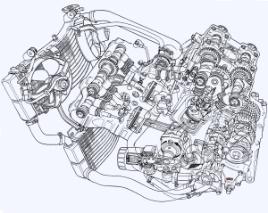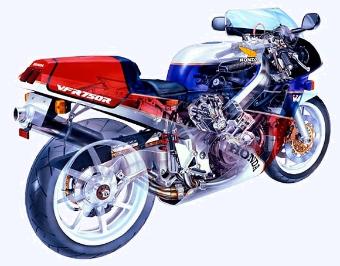
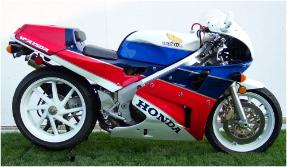
The inimitable Honda VFR750R
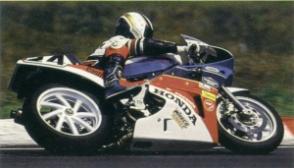
Reuben McMurter in 1988
In the sound clips the street bike is shifted at 12,200 RPM, the race bike at 11,500 RPM.
See #2 in the Articles section if you want to know how I figured out the shift points.
These sound clips are from the vinyl record that came with the Japanese RC30 brochure that I digitized. A very rare document of which I think I have two. The voice is obviously a Japanese dude trying to sound like an American.
Winning is Everything
Everyone knows the RC30 is a race bike with mirrors, horn, signals and an air filter. Honda built it for navigating around race tracks so a mention of the racing is in order. The Honda RC30 was simply too much for the competition. A lot of the RC30's great performances were by non factory equipped riders making the racing even better, if a bit one sided manufacturer wise.
The Isle of Man is the RC30's ancestral home. Little wonder the RC30 and the RC30 based RVF's made Mona's Isle their realm. An excellent suspension, a tough and flexible engine, ease of use, and the best testosterone filled riders made for some jaw dropping lap speeds. In spite of the RC30's intended dominance in TT and Endurance racing, the VFR750R the RC30 was also quite good at the short circuits; Fred Merkel and Oscar Rumi are testament to that statement.
Some of the Honda RC30 race history (1988 and 1989 ONLY):
- 1988 Australian Superbike Championship.
- 1988 Austrian Superbike Championship.
- 1988 Canadian Superbike Championship (see picture above).
- 1988 FIM Formula 1 Title.
- 1988 FIM World Superbike Rider and Manufacturer Championships.
- 1988 Isle of Man Production B, Formula 1 and Senior Wins.
- 1989 Australian Superbike Championship.
- 1989 British Superbike / Supercup Championship.
- 1989 FIM Formula 1 Title.
- 1989 FIM World Superbike Rider and Manufacturer Championships.
- 1989 French Superbike Championship.
- 1989 German Superbike.
- 1989 Isle of Man Production B and Formula 1.
- 1989 Spanish Superbike Championship.
- 1989 Suzuka 8 Hours (in reality Alex and Dominique rode an RVF).
After 1989 it becomes an enormous task to account for the individual wins, championships and broken records. From 1990 to 1993 (and later) the RC30 was still competitive at top levels. Some of the memorable retirement years racing would include:
- 1993 Australian Superbike Championship with Troy Corser riding a very much modified and well used machine.
- James Fraser duking it out with the factory superbike teams on his rat-bike.
- Nick Jeffries winning the 1993 Isle of Man F1 Race on the RC30 based RVF. Followed home by three more RVF/RC30s.
- Phillip McCallen winning the 1993 Isle of Man Senior Race on the RC30 based RVF. Also followed home by three more RVF/RC30.
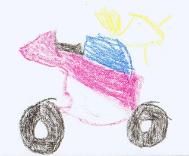
Then and Now
The RC30 was expensive no question. A 2010 VFR800 listed at $15,500 in Canada, the RC30 was $18,000 in 1989. That $18,000 translates into $28,000 2010 Canadian dollars using the Bank of Canada's average inflation rate of 2.09%. That puts it into perspective. But with such a step in motorcycling performance the measure of the machine cannot be registered in sticker prices or sales statistics. Honda proved the V-four engine was viable from club to world level racing. What Honda spent on the RC30 reaped rewards for many years. Contemporary popularity indicates the sense of Honda's decision to build a machine like this one.
The RC30 is now generally considered outperformed by most late model sportbikes, especially on the track. Technology can do that, especially when there are changes nearly every single year for decades. The RC30 was built essentially unchanged for a four year period (1987 to 1990) with it's early roots dating back to the 1985 RVF750 and the 6X. The RC30 does not put out extraordinary horsepower, some 750's in the late 80's made more peak horsepower. Honda took a different route with the RC30's big bang crankshaft that helps produce an impressive flat, wide torque curve. Even the peak torque, around 53 ft*lb (72 N*m), isn't mind boggling when looking at a modern liter bike. It's all in how it's delivered, and it may seem slow but it really is not. I think the current hp race is silly when the usual sportbike purchaser is a kid with a bunny hug and runners as riding gear. Horsepower dictates top speed, torque dictates acceleration. Those are facts.Though a standard full power RC30 is an impressive bike to ride, HRC did its thing with the RC30 as well. HRC supplied race kits with components to improve the engine and the suspension. The engine kit released some RPM and the corresponding horsepower. The suspension kit was relatively basic, mostly minor upgrades. The engine kits were more comprehensive but still nothing more than old school hot-rodding. A private race prepped engine with more compression, hotter camshafts, richer jetting, air inlet mods and free flow exhaust should be in the 130 hp range. Skilled assembly methods and tuning could net a few more horsepower. Be careful what HRC mods you do to a bike though. Often all of the system components are not part of what you may buy. Just as an examples; the HRC shock linkage requires the use of a different shock absorber with a longer stroke, and installing HRC camshafts requires modifications to the camshaft holders and valve covers.
Honda also made some special engines for the RC30 known as the NL0B series. The biggest internal design changes were in the cylinder heads, crankshaft and camshaft drives. Honda sought lower friction and higher engine speeds. The heads had shorter ports, different camshafts and holders with the camshafts rotating in the opposite direction. The firing order was retained at 360 degrees between throws. The camshafts also lost the preload gears, same as the HRC kit camshafts, necessitating manual adjustment of the backlash for more precise valve timing. These engines ran at upwards of 14,000 RPM+. These engines were Honda's attempt to join the hp race. Troy Corser used one to good effect in Australia in 1993.
The other major race parts supplier for, and push behind, the RC30 was Moriwaki. Moriwaki went a bit bananas here in my opinion. For their all out machine they stuck to the "Zero" philosophy of using their own frames. Improving on Honda's RVF derived frame is a big undertaking. I question the necessity of what they did, but admittedly some performance gains could be realized by dumping the single sided swingarm and fine tuning geometry and engine position. Moriwaki would sell you everything you needed to build your own Suzuka 8hr machine. All it took was money. Moriwaki had frames, forks (Kayaba), Keihin FCR's, dry clutch, short port heads, big valves, race exhausts, wheels (Marvic oddballs). Pretty much all they kept from Honda was the engine. Moriwaki would use the HRC catalog for components they would have built similarly, like radiators, oil pan and the like. Wehn Honda brought out the NL0B works RVF's it all became kind of pointless for Moriwaki. The sheer quantity of RVF's at Suzuka made sure that Moriwaki was not going to be a player.
By entering this website you agree to the site's TERMS OF USE
